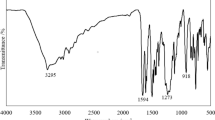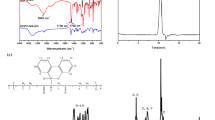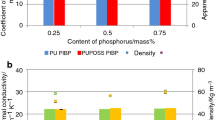Abstract
Flexible polyurethane foam (FPUF) has a widespread application across aerospace, furniture and vehicles, while its flammability always arouses severe safety concerns. Herein, a novel, bio-based flame retardant, i.e. polyol (PADEA) that contains phosphorus and nitrogen elements, was successfully synthesized by using phytic acid (a bio-organic acid) and diethanolamine as crude materials. Then, PADEA partially substituted the commercial polyether polyols in the foaming process, during which PADEA reacted in situ with isocyanate to construct an inherently flame-retardant FPUF. Due to the purposive designed P-N synergistic molecular structure, PADEA can serve as a highly efficient intumescent flame-retardant (IFR) system. When 40 php (ca. 21.51wt%) PADEA was added into the system, the limiting oxygen index (LOI) of the obtained FPUF reached up to 24.1%, achieving a 22.0% increase compared to that of primitive FPUF without PADEA. Moreover, the addition of PADEA can considerably reduce the total number of melt drips in the UL-94 HB rating test. And the cone calorimeter (CC) results demonstrated a 47.08% reduction in total heat release (THR) was achieved as 40 php PADEA was added. At the end, various characterization methods were carried out, revealing the flame-retardant mechanism of PADEA both in condense and gaseous phase. This work highlights a facile and green strategy for designing functional polyol to address the flame-retardant issues of high-performance FPUF.
Graphical Abstract
















Similar content being viewed by others
Data Availability
Data will be made available on request.
References
Bhoyate S, Ionescu M, Kahol PK, Gupta RK (2018) Sustainable flame-retardant polyurethanes using renewable resources. Ind Crops Prod 123:480–488. https://doi.org/10.1016/j.indcrop.2018.07.025
Chen M-J, Shao Z-B, Wang X-L, Chen L, Wang Y-Z (2012) Ind Eng Chem Res 51(29):9769–9776. https://doi.org/10.1021/ie301004d. Flame-Retardant Flexible Polyurethane Foam with a Novel Nitrogen–Phosphorus Flame Retardant
Chen M-J, Xu Y-J, Rao W-H, Huang J-Q, Wang X-L, Chen L, Wang Y-Z (2014) Influence of Valence and structure of phosphorus-containing melamine salts on the decomposition and Fire behaviors of flexible polyurethane foams. Ind Eng Chem Res 53(21):8773–8783. https://doi.org/10.1021/ie500691p
Pan Y, Liu L, Cai W, Hu Y, Jiang S, Zhao H (2019) Effect of layer-by-layer self-assembled sepiolite-based nanocoating on flame retardant and smoke suppressant properties of flexible polyurethane foam. Appl Clay Sci 168:230–236. https://doi.org/10.1016/j.clay.2018.11.014
Yang S, Wang S, Du X, Du Z, Cheng X, Wang H (2020) Mechanically robust self-healing and recyclable flame-retarded polyurethane elastomer based on thermoreversible crosslinking network and multiple hydrogen bonds. Chem Eng J. https://doi.org/10.1016/j.cej.2019.123544
Kim YS, Jeon ES (2023) Analysis of mechanical and flame-retardant properties of flexible polyurethane foams. J Appl Polym Sci. https://doi.org/10.1002/app.54670
Rao W-H, Zhu Z-M, Wang S-X, Wang T, Tan Y, Liao W, Zhao H-B, Wang Y-Z (2018) A reactive phosphorus-containing polyol incorporated into flexible polyurethane foam: self-extinguishing behavior and mechanism. Polym Degrad Stab 153:192–200. https://doi.org/10.1016/j.polymdegradstab.2018.04.029
Laufer G, Kirkland C, Morgan AB, Grunlan JC (2013) Exceptionally flame retardant sulfur-based multilayer nanocoating for polyurethane prepared from aqueous polyelectrolyte solutions. ACS Macro Lett 2(5):361–365. https://doi.org/10.1021/mz400105e
Cao K, Wu S-l, Qiu S-l, Li Y, Yao Z (2012) Synthesis ofn-alkoxy hindered amine containing silane as a multifunctional flame retardant synergist and its application in intumescent flame retardant polypropylene. Ind Eng Chem Res. https://doi.org/10.1021/ie3017048
Chen L, Song L, Lv P, Jie G, Tai Q, Xing W, Hu Y (2011) A new intumescent flame retardant containing phosphorus and nitrogen: Preparation, thermal properties and application to UV curable coating. Prog Org Coat 70(1):59–66. https://doi.org/10.1016/j.porgcoat.2010.10.002
Gao F, Tong L, Fang Z (2006) Effect of a novel phosphorous–nitrogen containing intumescent flame retardant on the Fire retardancy and the thermal behaviour of poly(butylene terephthalate). Polym Degrad Stab 91(6):1295–1299. https://doi.org/10.1016/j.polymdegradstab.2005.08.013
Wang H, Liu Q, Li H, Zhang H, Yan S (2023) Flame-retardant and smoke-suppressant flexible polyurethane foams based on phosphorus-containing polyester diols and expandable graphite. Polymers. https://doi.org/10.3390/polym15051284
Rao WH, Liao W, Wang H, Zhao HB, Wang YZ (2018) Flame-retardant and smoke-suppressant flexible polyurethane foams based on reactive phosphorus-containing polyol and expandable graphite. J Hazard Mater 360:651–660. https://doi.org/10.1016/j.jhazmat.2018.08.053
Bhoyate S, Ionescu M, Radojcic D, Kahol PK, Chen J, Mishra SR, Gupta RK (2018) Highly flame-retardant bio-based polyurethanes using novel reactive polyols. J Appl Polym Sci. https://doi.org/10.1002/app.46027
Zhou F, Ma C, Zhang K, Yy Chan, Xiao Y, Schartel B, Doring M, Wang B, Hu W, Hu Y (2021) Synthesis of Ethyl (Diethoxymethyl)phosphinate derivatives and their flame retardancy in flexible polyurethane foam: structure-flame retardancy relationships. Polym Degrad Stab. https://doi.org/10.1016/j.polymdegradstab.2021.109557
Chen M-J, Chen C-R, Tan Y, Huang J-Q, Wang X-L, Chen L, Wang Y-Z (2014) Ind Eng Chem Res 53(3):1160–1171. https://doi.org/10.1021/ie4036753. Inherently Flame-Retardant Flexible Polyurethane Foam with Low Content of Phosphorus-Containing Cross-Linking Agent
Ding H, Huang K, Li S, Xu L, Xia J, Li M (2017) Synthesis of a novel phosphorus and nitrogen-containing bio-based polyol and its application in flame retardant polyurethane foam. J Anal Appl Pyrol 128:102–113. https://doi.org/10.1016/j.jaap.2017.10.020
Frigione M, Maffezzoli A, Finocchiaro P, Failla S (2003) Cure kinetics and properties of epoxy resins containing a phosphorous-based flame retardant. Adv Polym Technol 22(4):329–342. https://doi.org/10.1002/adv.10060
Bai W, Zhang X, Chen Y, Lian Z, Zheng S, Chen X, Lin Y, Jian R (2023) Environmental-friendly biomass-based Janus ink/urushiol modified cotton fabric for efficient solar-driven interfacial evaporation. Chem Eng J. https://doi.org/10.1016/j.cej.2023.146784
Alongi J, Colleoni C, Malucelli G, Rosace G (2012) Hybrid phosphorus-doped silica architectures derived from a multistep sol–gel process for improving thermal stability and flame retardancy of cotton fabrics. Polym Degrad Stab 97(8):1334–1344. https://doi.org/10.1016/j.polymdegradstab.2012.05.030
Dong C, Lu Z, Zhang F, Zhu P, Wang P, Che Y, Sui S (2015) Combustion behaviors of cotton fabrics treated by a novel nitrogen- and phosphorus-containing polysiloxane flame retardant. J Therm Anal Calorim 123(1):535–544. https://doi.org/10.1007/s10973-015-4914-4
Xi W, Qian L, Huang Z, Cao Y, Li L (2016) Continuous flame-retardant actions of two phosphate esters with expandable graphite in rigid polyurethane foams. Polym Degrad Stab 130:97–102. https://doi.org/10.1016/j.polymdegradstab.2016.06.003
Wang Y, Ma L, Yuan J, Zhu Z, Liu X, Li D, He L, Xiao F (2023) Furfural-based P/N/S flame retardant towards high-performance epoxy resins with flame retardancy, toughness, low dielectric properties and UV resistance. Polym Degrad Stab. https://doi.org/10.1016/j.polymdegradstab.2023.110343
Liu X-D, Zheng X-T, Dong Y-Q, He L-X, Chen F, Bai W-B, Lin Y-C, Jian R-K (2022) A novel nitrogen-rich phosphinic amide towards flame-retardant, smoke suppression and mechanically strengthened epoxy resins. Polym Degrad Stab. https://doi.org/10.1016/j.polymdegradstab.2022.109840
Tong Y, Wu W, Zhao W, Xing Y, Zhang H, Wang C, Chen TBY, Yuen ACY, Yu B, Cao X, Yi X (2022) Nanohybrid of Co3O4 nanoparticles and polyphosphazene-decorated ultra-thin boron nitride nanosheets for simultaneous enhancement in fire safety and smoke suppression of thermoplastic polyurethane. Polymers. https://doi.org/10.3390/polym14204341
Dong Y-Q, Bai W-B, Zhang W, Lin Y-C, Jian R-K (2023) Bio-based phytic acid@polyurushiol–titanium complex coated cotton fabrics with durable flame retardancy for oil-water separation. Int J Biol Macromol. https://doi.org/10.1016/j.ijbiomac.2023.123782
Zhang B, Yang S, Liu M, Wen P, Liu X, Tang G, Xu X (2022) Bio-based trivalent phytate: a Novel Strategy for Enhancing Fire performance of rigid polyurethane foam composites. J Renew Mater 10(5):1201–1220. https://doi.org/10.32604/jrm.2022.018047
Rao W-H, Xu H-X, Xu Y-J, Qi M, Liao W, Xu S, Wang Y-Z (2018) Persistently flame-retardant flexible polyurethane foams by a novel phosphorus-containing polyol. Chem Eng J 343:198–206. https://doi.org/10.1016/j.cej.2018.03.013
Singh H, Sharma TP, Jain AK (2007) Reactivity of the raw materials and their effects on the structure and properties of rigid polyurethane foams. J Appl Polym Sci 106(2):1014–1023. https://doi.org/10.1002/app.26525
Li P, Jiang X-C, Song W-M, Zhang L-Y, Xu Y-J, Liu Y, Zhu P (2023) Green organic-inorganic coatings for flexible polyurethane foams: evaluation of the effects on flame retardancy, antibacterial activity, and ideal mechanical properties. J Clean Prod. https://doi.org/10.1016/j.jclepro.2023.137265
Liao H, Duan W, Liu Y, Wang Q, Wen H (2021) Flame retardant and leaking preventable phase change materials for thermal energy storage and thermal regulation. J Energy Storage. https://doi.org/10.1016/j.est.2021.102248
Wu X, Gou T, Zhao Q, Chen L, Wang P (2022) High-efficiency durable flame retardant with ammonium phosphate ester and phosphine oxide groups for cotton cellulose biomacromolecule. Int J Biol Macromol 194:945–953. https://doi.org/10.1016/j.ijbiomac.2021.11.149
Zheng Z, Liu Bingnan Wang S, Yang T, Cui X, Wang H (2015) Preparation of a novel phosphorus- and nitrogen-containing flame retardant and its synergistic effect in the intumescent flame-retarding polypropylene system. Polym Compos 36(9):1606–1619. https://doi.org/10.1002/pc.23069
Zhang B, Feng Z, Yang Y, Xu X, Chen D, Huang X, Liu C, Liu X, Tang G (2022) Facile synthesis of melamine phytates and its application in rigid polyurethane foam composites targets for improving Fire safety. Plast Rubber Compos 52(3):145–159. https://doi.org/10.1080/14658011.2021.2024647
Wang P-J, Liao D-J, Hu X-P, Pan N, Li W-X, Wang D-Y, Yao Y (2019) Facile fabrication of biobased P N C-containing nano-layered hybrid: Preparation, growth mechanism and its efficient Fire retardancy in epoxy. Polym Degrad Stab 159:153–162. https://doi.org/10.1016/j.polymdegradstab.2018.11.024
Sykam K, Försth M, Sas G, Restás Á, Das O (2021) Phytic acid: a bio-based flame retardant for cotton and wool fabrics. Ind Crops Prod. https://doi.org/10.1016/j.indcrop.2021.113349
Li P, Liu C, Jiang Q, Tao Y, Xu Y, Liu Y, Zhu P (2022) Halogen-free Coatings combined with the synergistic effect of phytic acid and montmorillonite for fire safety flexible polyurethane foam. Macromol Mater Eng. https://doi.org/10.1002/mame.202100930
Yang Y, Zhang G, Yu F, Liu M, Yang S, Tang G, Xu X, Wang B, Liu X (2021) Flame retardant rigid polyurethane foam composites based on iron tailings and aluminum phosphate: a novel strategy for utilizing industrial solid wastes. Polym Adv Technol 32(12):4826–4839. https://doi.org/10.1002/pat.5474
Zhang Q, Wang J, Yang S, Cheng J, Ding G, Huo S (2019) Facile construction of one-component intrinsic flame-retardant epoxy resin system with fast curing ability using imidazole-blocked bismaleimide. Compos Part B. https://doi.org/10.1016/j.compositesb.2019.107380
Wang S, Yang F, Sun W, Xu X, Deng Y (2023) Bio-based flame‐retardant rigid polyurethane foam with high content of soybean oil polyols containing phosphorus. J Am Oil Chem Soc 100(7):561–577. https://doi.org/10.1002/aocs.12706
Cain AA, Nolen CR, Li Y-C, Davis R, Grunlan JC (2013) Phosphorous-filled nanobrick wall multilayer thin film eliminates polyurethane melt dripping and reduces heat release associated with Fire. Polym Degrad Stab 98(12):2645–2652. https://doi.org/10.1016/j.polymdegradstab.2013.09.028
Yang S, Zhang B, Liu M, Yang Y, Liu X, Chen D, Wang B, Tang G, Liu X (2021) Fire performance of piperazine phytate modified rigid polyurethane foam composites. Polym Adv Technol 32(11):4531–4546. https://doi.org/10.1002/pat.5454
Jiang Z, Wang C, Fang S, Ji P, Wang H, Ji C (2018) Durable flame-retardant and antidroplet finishing of polyester fabrics with flexible polysiloxane and phytic acid through layer-by-layer assembly and sol-gel process. J Appl Polym Sci. https://doi.org/10.1002/app.46414
Bhoyate S, Ionescu M, Kahol PK, Chen J, Mishra SR, Gupta RK (2018) Highly flame-retardant polyurethane foam based on reactive phosphorus polyol and limonene-based polyol. J Appl Polym Sci. https://doi.org/10.1002/app.46224
Garrido MA, Font R (2015) Pyrolysis and combustion study of flexible polyurethane foam. J Anal Appl Pyrol 113:202–215. https://doi.org/10.1016/j.jaap.2014.12.017
Yin Z, Lu J, Hong N, Cheng W, Jia P, Wang H, Hu W, Wang B, Song L, Hu Y (2022) Functionalizing Ti(3)C(2)T(x) for enhancing Fire resistance and reducing toxic gases of flexible polyurethane foam composites with reinforced mechanical properties. J Colloid Interface Sci 607(Pt 2):1300–1312. https://doi.org/10.1016/j.jcis.2021.09.027
Zou J, Duan H, Chen Y, Ji S, Cao J, Ma H (2020) A P/N/S-containing high-efficiency flame retardant endowing epoxy resin with excellent flame retardance, mechanical properties and heat resistance. Compos Part B. https://doi.org/10.1016/j.compositesb.2020.108228
Rao W-H, Hu Z-Y, Xu H-X, Xu Y-J, Qi M, Liao W, Xu S, Wang Y-Z (2017) Flame-retardant flexible polyurethane foams with highly efficient melamine salt. Ind Eng Chem Res 56(25):7112–7119. https://doi.org/10.1021/acs.iecr.7b01335
Funding
This work was financially supported by the Natural Science Foundation of China (Grant No: 52103080), Yunnan Fundamental Research Projects (Grant No. 202201AT070115, 202101AU070012 and 202201BE070001-031), Yunnan Major Scientific and Technological Projects (grant No. 202202AG050001), and the Analysis and Testing Foundation of Kunming University of Science and Technology (Grant No. 2021T20200023 and 2021T20150083).
Author information
Authors and Affiliations
Contributions
MY: Investigation, validation, Writing—original draft. CZ: Methodology, investigation, validation, formal analysis. XY: Conceptualization, supervision, writing—review & editing, funding acquisition. CJ: Investigation, visualization. XS: Investigation. MY: Resources, investigation. WF: Visualization, data curation. FD: Resources, investigation. MY: Supervision, funding acquisition. XD: Supervision, project administration, Writing—review & editing, funding acquisition.
Corresponding authors
Ethics declarations
Competing Interest
The authors declare that they have no known competing financial interests or personal relationships that could have appeared to influence the work reported in this paper.
Additional information
Publisher’s Note
Springer Nature remains neutral with regard to jurisdictional claims in published maps and institutional affiliations.
Supplementary Information
Below is the link to the electronic supplementary material.
Rights and permissions
Springer Nature or its licensor (e.g. a society or other partner) holds exclusive rights to this article under a publishing agreement with the author(s) or other rightsholder(s); author self-archiving of the accepted manuscript version of this article is solely governed by the terms of such publishing agreement and applicable law.
About this article
Cite this article
Mo, Y., Cheng, Z., Xie, Y. et al. A Bio-Based Polyol with Synergetic Phosphorous and Nitrogenous Effect for Constructing Intrinsic Flame-Retardant Flexible Polyurethane Foam. J Polym Environ (2024). https://doi.org/10.1007/s10924-023-03157-6
Accepted:
Published:
DOI: https://doi.org/10.1007/s10924-023-03157-6




